Project Scheduling and Time Management Report - University Name
VerifiedAdded on 2023/01/10
|10
|1590
|88
Report
AI Summary
This report provides a detailed overview of project scheduling and time management, covering essential concepts and methodologies. It begins by exploring the role and skills of a project manager in effective time management, highlighting the significance of timely project delivery. The report then delves into the Work Breakdown Structure (WBS), explaining its structure, decomposition process, and benefits, along with a practical example. It also examines tools for gathering customer requirements, including interviewing, surveys, workshops, and direct communication. The Critical Path Methodology (CPM) is introduced, including its advantages in project scheduling, monitoring, and cost control. Finally, the report outlines the phases of designing a project schedule according to PMBOK and discusses potential challenges and conflicts in using schedules on projects, such as resource allocation and change management. The report is designed to assist students in understanding and applying project management principles. Access to this and other assignments are available on Desklib, a platform providing AI based study tools.
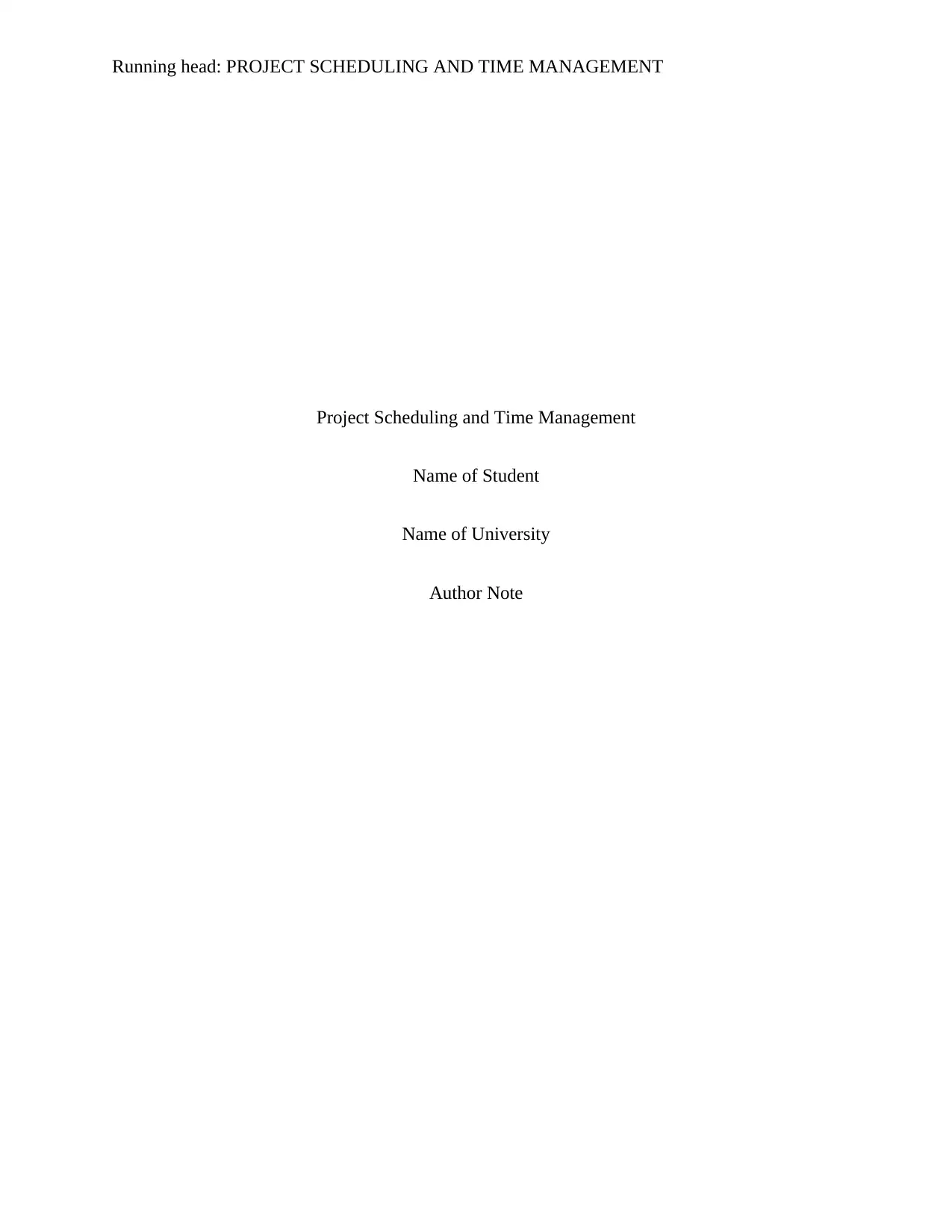
Running head: PROJECT SCHEDULING AND TIME MANAGEMENT
Project Scheduling and Time Management
Name of Student
Name of University
Author Note
Project Scheduling and Time Management
Name of Student
Name of University
Author Note
Paraphrase This Document
Need a fresh take? Get an instant paraphrase of this document with our AI Paraphraser
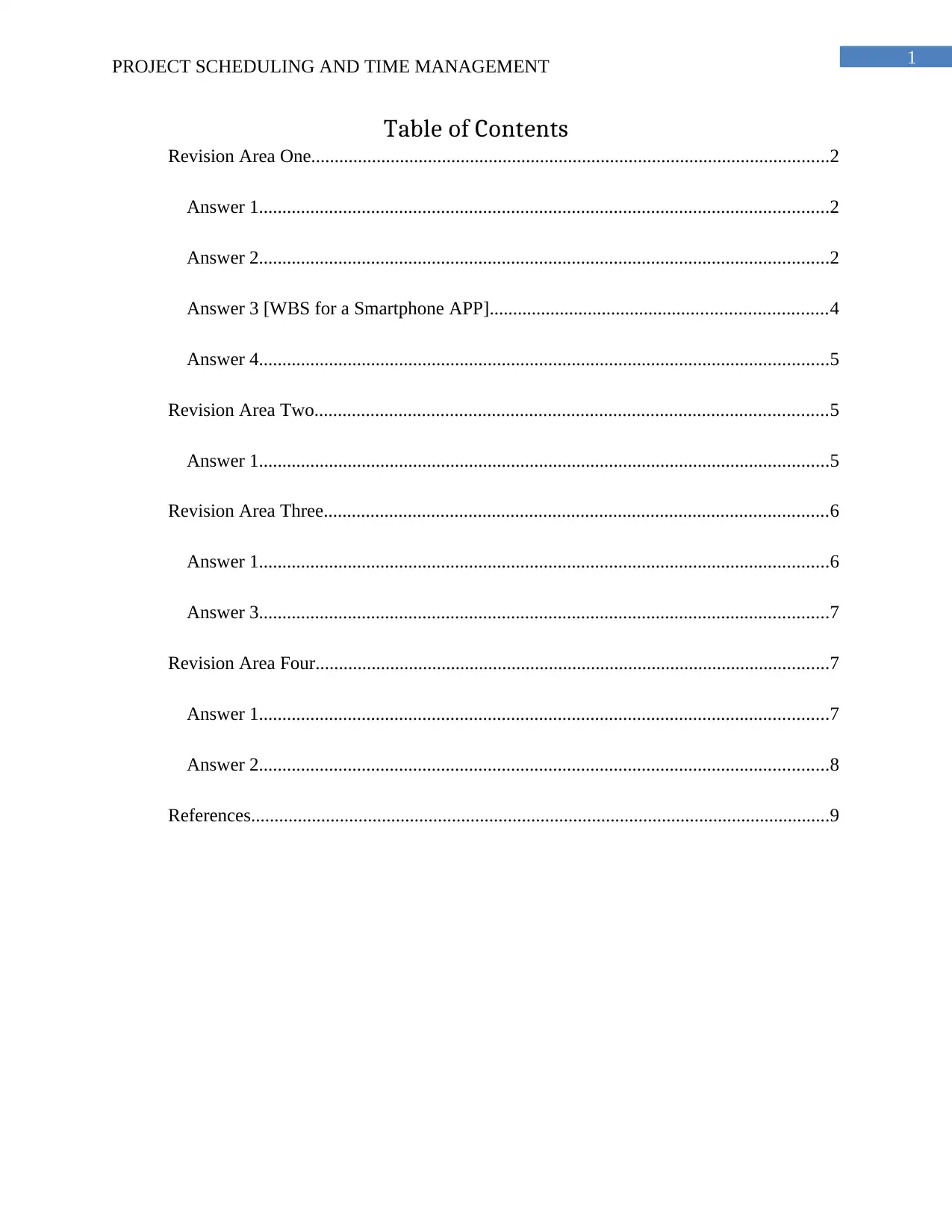
1PROJECT SCHEDULING AND TIME MANAGEMENT
Table of Contents
Revision Area One...............................................................................................................2
Answer 1..........................................................................................................................2
Answer 2..........................................................................................................................2
Answer 3 [WBS for a Smartphone APP]........................................................................4
Answer 4..........................................................................................................................5
Revision Area Two..............................................................................................................5
Answer 1..........................................................................................................................5
Revision Area Three............................................................................................................6
Answer 1..........................................................................................................................6
Answer 3..........................................................................................................................7
Revision Area Four..............................................................................................................7
Answer 1..........................................................................................................................7
Answer 2..........................................................................................................................8
References............................................................................................................................9
Table of Contents
Revision Area One...............................................................................................................2
Answer 1..........................................................................................................................2
Answer 2..........................................................................................................................2
Answer 3 [WBS for a Smartphone APP]........................................................................4
Answer 4..........................................................................................................................5
Revision Area Two..............................................................................................................5
Answer 1..........................................................................................................................5
Revision Area Three............................................................................................................6
Answer 1..........................................................................................................................6
Answer 3..........................................................................................................................7
Revision Area Four..............................................................................................................7
Answer 1..........................................................................................................................7
Answer 2..........................................................................................................................8
References............................................................................................................................9
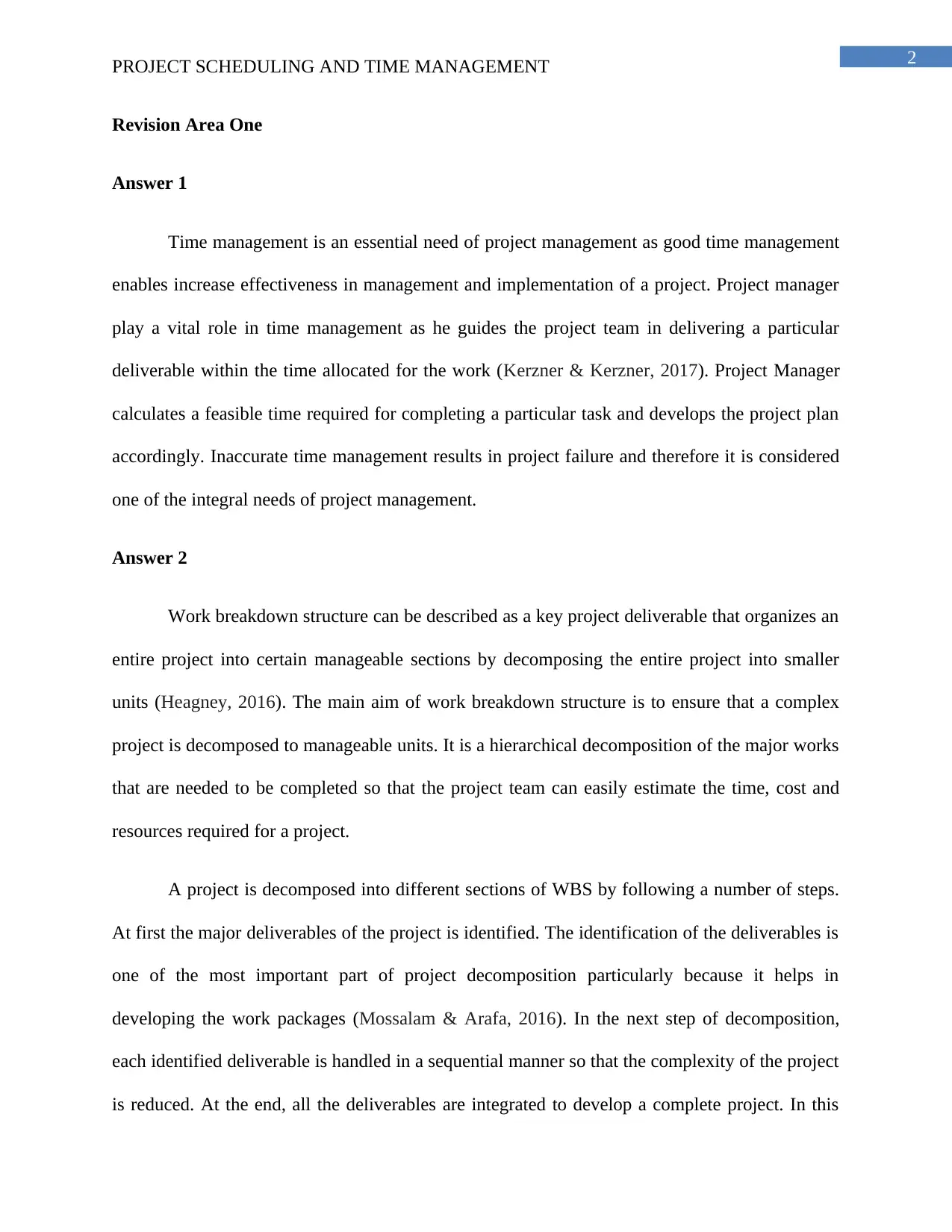
2PROJECT SCHEDULING AND TIME MANAGEMENT
Revision Area One
Answer 1
Time management is an essential need of project management as good time management
enables increase effectiveness in management and implementation of a project. Project manager
play a vital role in time management as he guides the project team in delivering a particular
deliverable within the time allocated for the work (Kerzner & Kerzner, 2017). Project Manager
calculates a feasible time required for completing a particular task and develops the project plan
accordingly. Inaccurate time management results in project failure and therefore it is considered
one of the integral needs of project management.
Answer 2
Work breakdown structure can be described as a key project deliverable that organizes an
entire project into certain manageable sections by decomposing the entire project into smaller
units (Heagney, 2016). The main aim of work breakdown structure is to ensure that a complex
project is decomposed to manageable units. It is a hierarchical decomposition of the major works
that are needed to be completed so that the project team can easily estimate the time, cost and
resources required for a project.
A project is decomposed into different sections of WBS by following a number of steps.
At first the major deliverables of the project is identified. The identification of the deliverables is
one of the most important part of project decomposition particularly because it helps in
developing the work packages (Mossalam & Arafa, 2016). In the next step of decomposition,
each identified deliverable is handled in a sequential manner so that the complexity of the project
is reduced. At the end, all the deliverables are integrated to develop a complete project. In this
Revision Area One
Answer 1
Time management is an essential need of project management as good time management
enables increase effectiveness in management and implementation of a project. Project manager
play a vital role in time management as he guides the project team in delivering a particular
deliverable within the time allocated for the work (Kerzner & Kerzner, 2017). Project Manager
calculates a feasible time required for completing a particular task and develops the project plan
accordingly. Inaccurate time management results in project failure and therefore it is considered
one of the integral needs of project management.
Answer 2
Work breakdown structure can be described as a key project deliverable that organizes an
entire project into certain manageable sections by decomposing the entire project into smaller
units (Heagney, 2016). The main aim of work breakdown structure is to ensure that a complex
project is decomposed to manageable units. It is a hierarchical decomposition of the major works
that are needed to be completed so that the project team can easily estimate the time, cost and
resources required for a project.
A project is decomposed into different sections of WBS by following a number of steps.
At first the major deliverables of the project is identified. The identification of the deliverables is
one of the most important part of project decomposition particularly because it helps in
developing the work packages (Mossalam & Arafa, 2016). In the next step of decomposition,
each identified deliverable is handled in a sequential manner so that the complexity of the project
is reduced. At the end, all the deliverables are integrated to develop a complete project. In this
⊘ This is a preview!⊘
Do you want full access?
Subscribe today to unlock all pages.

Trusted by 1+ million students worldwide

3PROJECT SCHEDULING AND TIME MANAGEMENT
way, a critical project is decomposed into manageable units so that the complexity of the project
can be reduced.
way, a critical project is decomposed into manageable units so that the complexity of the project
can be reduced.
Paraphrase This Document
Need a fresh take? Get an instant paraphrase of this document with our AI Paraphraser
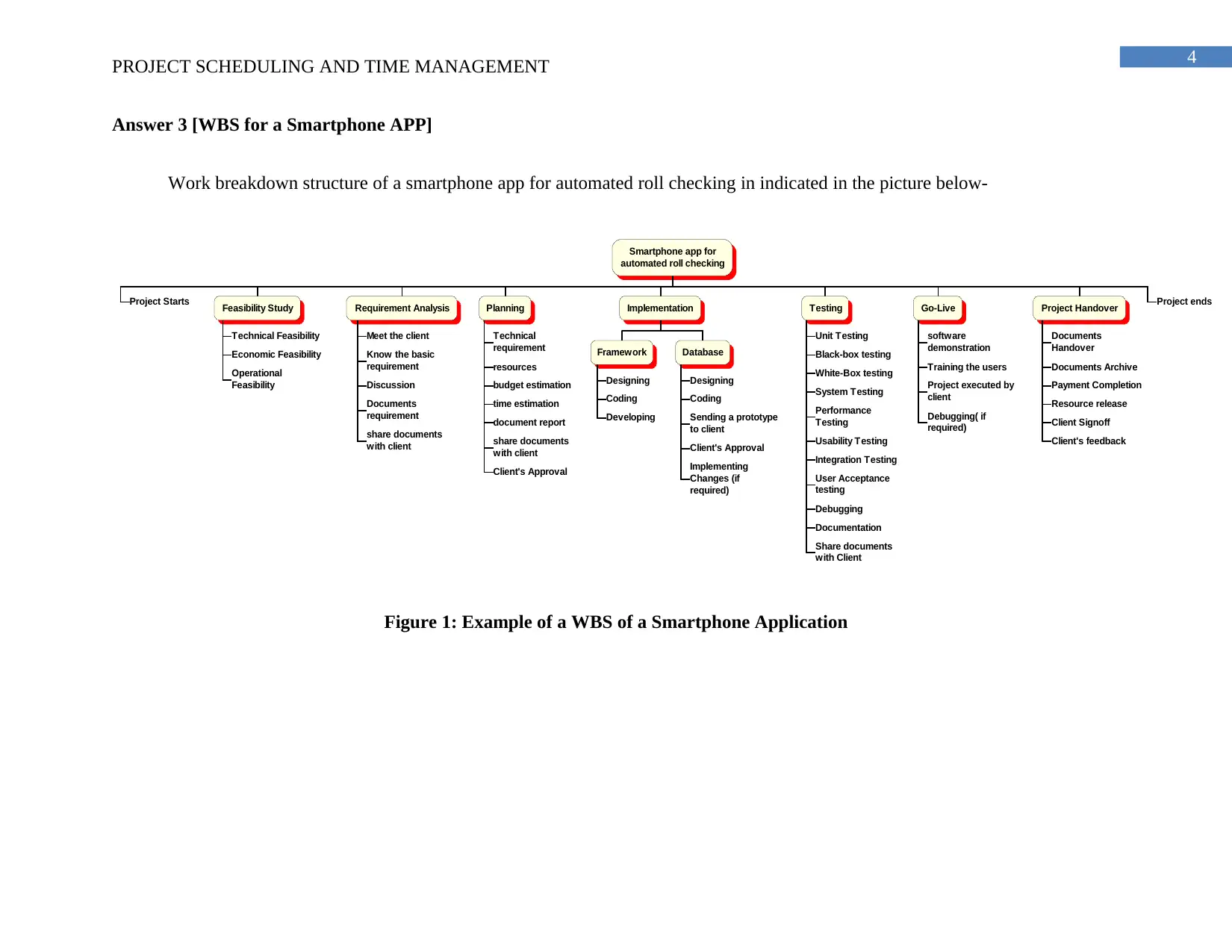
4PROJECT SCHEDULING AND TIME MANAGEMENT
Answer 3 [WBS for a Smartphone APP]
Work breakdown structure of a smartphone app for automated roll checking in indicated in the picture below-
Smartphone app for
automated roll checking
Project Starts Feasibility Study
Technical Feasibility
Economic Feasibility
Operational
Feasibility
Requirement Analysis
Meet the client
Know the basic
requirement
Discussion
Documents
requirement
share documents
with client
Planning
Technical
requirement
resources
budget estimation
time estimation
document report
share documents
with client
Client's Approval
Implementation
Framework
Designing
Coding
Developing
Database
Designing
Coding
Sending a prototype
to client
Client's Approval
Implementing
Changes (if
required)
Testing
Unit Testing
Black-box testing
White-Box testing
System Testing
Performance
Testing
Usability Testing
Integration Testing
User Acceptance
testing
Debugging
Documentation
Share documents
with Client
Go-Live
software
demonstration
Training the users
Project executed by
client
Debugging( if
required)
Project Handover
Documents
Handover
Documents Archive
Payment Completion
Resource release
Client Signoff
Client's feedback
Project ends
Figure 1: Example of a WBS of a Smartphone Application
Answer 3 [WBS for a Smartphone APP]
Work breakdown structure of a smartphone app for automated roll checking in indicated in the picture below-
Smartphone app for
automated roll checking
Project Starts Feasibility Study
Technical Feasibility
Economic Feasibility
Operational
Feasibility
Requirement Analysis
Meet the client
Know the basic
requirement
Discussion
Documents
requirement
share documents
with client
Planning
Technical
requirement
resources
budget estimation
time estimation
document report
share documents
with client
Client's Approval
Implementation
Framework
Designing
Coding
Developing
Database
Designing
Coding
Sending a prototype
to client
Client's Approval
Implementing
Changes (if
required)
Testing
Unit Testing
Black-box testing
White-Box testing
System Testing
Performance
Testing
Usability Testing
Integration Testing
User Acceptance
testing
Debugging
Documentation
Share documents
with Client
Go-Live
software
demonstration
Training the users
Project executed by
client
Debugging( if
required)
Project Handover
Documents
Handover
Documents Archive
Payment Completion
Resource release
Client Signoff
Client's feedback
Project ends
Figure 1: Example of a WBS of a Smartphone Application

5PROJECT SCHEDULING AND TIME MANAGEMENT
Answer 4
There are a number of benefits of making use of a work breakdown structure. The major
one being the ability of managing the complex work processes and the critical tasks in a project.
The use of work breakdown structure helps in defining and organizing the work that is required
to be completed. Thus, the use of work breakdown structure helps in estimating the costs of the
project (Milosevic & Martinelli, 2016). A project manager is responsible for developing a high
level and well defined work breakdown structure, with an aim of identifying and categorizing
well defined tasks. Decomposition of a critical task into a number of sub-phases helps in creating
accountability and commitment among the project team. Work breakdown structure helps in
decomposition of the tasks in such a way that each unit is easily manageable.
Another advantage of work breakdown structure is that it helps in reducing the
complicated activities associated with a project to a collection of tasks. It is therefore, integral for
a project manager to develop a high level work breakdown structure that can help in better
management of the entire project.
Revision Area Two
Answer 1
Collection of customers’ requirement is considered to be a vital part of the planning
phase in project management. There are a number of ways in which a customers’ requirement
can be collected (Too & Weaver, 2014). Out of which, the five most prominent tools are,
interviewing, Questionnaires and surveys, observation, facilitated workshops and direct
communication.
Answer 4
There are a number of benefits of making use of a work breakdown structure. The major
one being the ability of managing the complex work processes and the critical tasks in a project.
The use of work breakdown structure helps in defining and organizing the work that is required
to be completed. Thus, the use of work breakdown structure helps in estimating the costs of the
project (Milosevic & Martinelli, 2016). A project manager is responsible for developing a high
level and well defined work breakdown structure, with an aim of identifying and categorizing
well defined tasks. Decomposition of a critical task into a number of sub-phases helps in creating
accountability and commitment among the project team. Work breakdown structure helps in
decomposition of the tasks in such a way that each unit is easily manageable.
Another advantage of work breakdown structure is that it helps in reducing the
complicated activities associated with a project to a collection of tasks. It is therefore, integral for
a project manager to develop a high level work breakdown structure that can help in better
management of the entire project.
Revision Area Two
Answer 1
Collection of customers’ requirement is considered to be a vital part of the planning
phase in project management. There are a number of ways in which a customers’ requirement
can be collected (Too & Weaver, 2014). Out of which, the five most prominent tools are,
interviewing, Questionnaires and surveys, observation, facilitated workshops and direct
communication.
⊘ This is a preview!⊘
Do you want full access?
Subscribe today to unlock all pages.

Trusted by 1+ million students worldwide
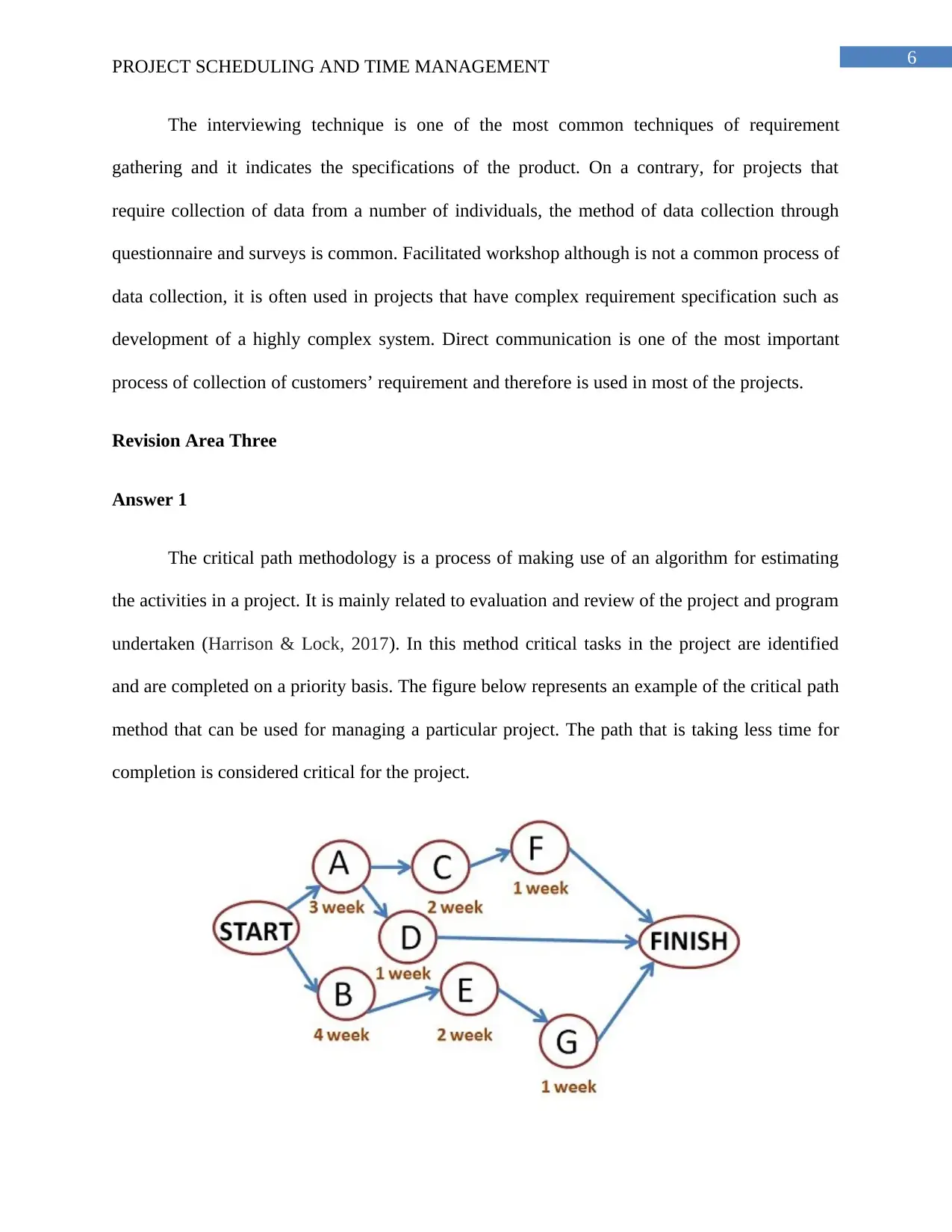
6PROJECT SCHEDULING AND TIME MANAGEMENT
The interviewing technique is one of the most common techniques of requirement
gathering and it indicates the specifications of the product. On a contrary, for projects that
require collection of data from a number of individuals, the method of data collection through
questionnaire and surveys is common. Facilitated workshop although is not a common process of
data collection, it is often used in projects that have complex requirement specification such as
development of a highly complex system. Direct communication is one of the most important
process of collection of customers’ requirement and therefore is used in most of the projects.
Revision Area Three
Answer 1
The critical path methodology is a process of making use of an algorithm for estimating
the activities in a project. It is mainly related to evaluation and review of the project and program
undertaken (Harrison & Lock, 2017). In this method critical tasks in the project are identified
and are completed on a priority basis. The figure below represents an example of the critical path
method that can be used for managing a particular project. The path that is taking less time for
completion is considered critical for the project.
The interviewing technique is one of the most common techniques of requirement
gathering and it indicates the specifications of the product. On a contrary, for projects that
require collection of data from a number of individuals, the method of data collection through
questionnaire and surveys is common. Facilitated workshop although is not a common process of
data collection, it is often used in projects that have complex requirement specification such as
development of a highly complex system. Direct communication is one of the most important
process of collection of customers’ requirement and therefore is used in most of the projects.
Revision Area Three
Answer 1
The critical path methodology is a process of making use of an algorithm for estimating
the activities in a project. It is mainly related to evaluation and review of the project and program
undertaken (Harrison & Lock, 2017). In this method critical tasks in the project are identified
and are completed on a priority basis. The figure below represents an example of the critical path
method that can be used for managing a particular project. The path that is taking less time for
completion is considered critical for the project.
Paraphrase This Document
Need a fresh take? Get an instant paraphrase of this document with our AI Paraphraser
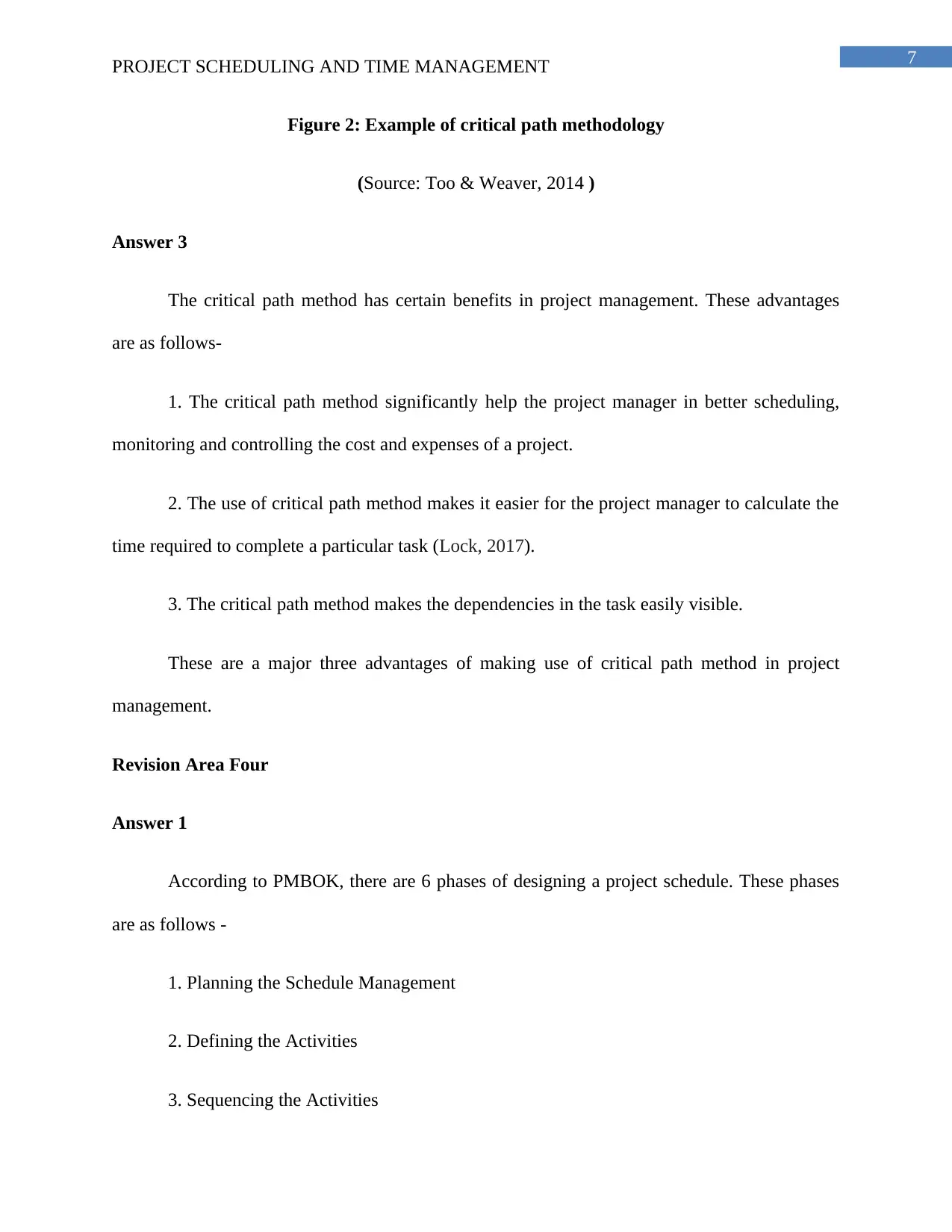
7PROJECT SCHEDULING AND TIME MANAGEMENT
Figure 2: Example of critical path methodology
(Source: Too & Weaver, 2014 )
Answer 3
The critical path method has certain benefits in project management. These advantages
are as follows-
1. The critical path method significantly help the project manager in better scheduling,
monitoring and controlling the cost and expenses of a project.
2. The use of critical path method makes it easier for the project manager to calculate the
time required to complete a particular task (Lock, 2017).
3. The critical path method makes the dependencies in the task easily visible.
These are a major three advantages of making use of critical path method in project
management.
Revision Area Four
Answer 1
According to PMBOK, there are 6 phases of designing a project schedule. These phases
are as follows -
1. Planning the Schedule Management
2. Defining the Activities
3. Sequencing the Activities
Figure 2: Example of critical path methodology
(Source: Too & Weaver, 2014 )
Answer 3
The critical path method has certain benefits in project management. These advantages
are as follows-
1. The critical path method significantly help the project manager in better scheduling,
monitoring and controlling the cost and expenses of a project.
2. The use of critical path method makes it easier for the project manager to calculate the
time required to complete a particular task (Lock, 2017).
3. The critical path method makes the dependencies in the task easily visible.
These are a major three advantages of making use of critical path method in project
management.
Revision Area Four
Answer 1
According to PMBOK, there are 6 phases of designing a project schedule. These phases
are as follows -
1. Planning the Schedule Management
2. Defining the Activities
3. Sequencing the Activities
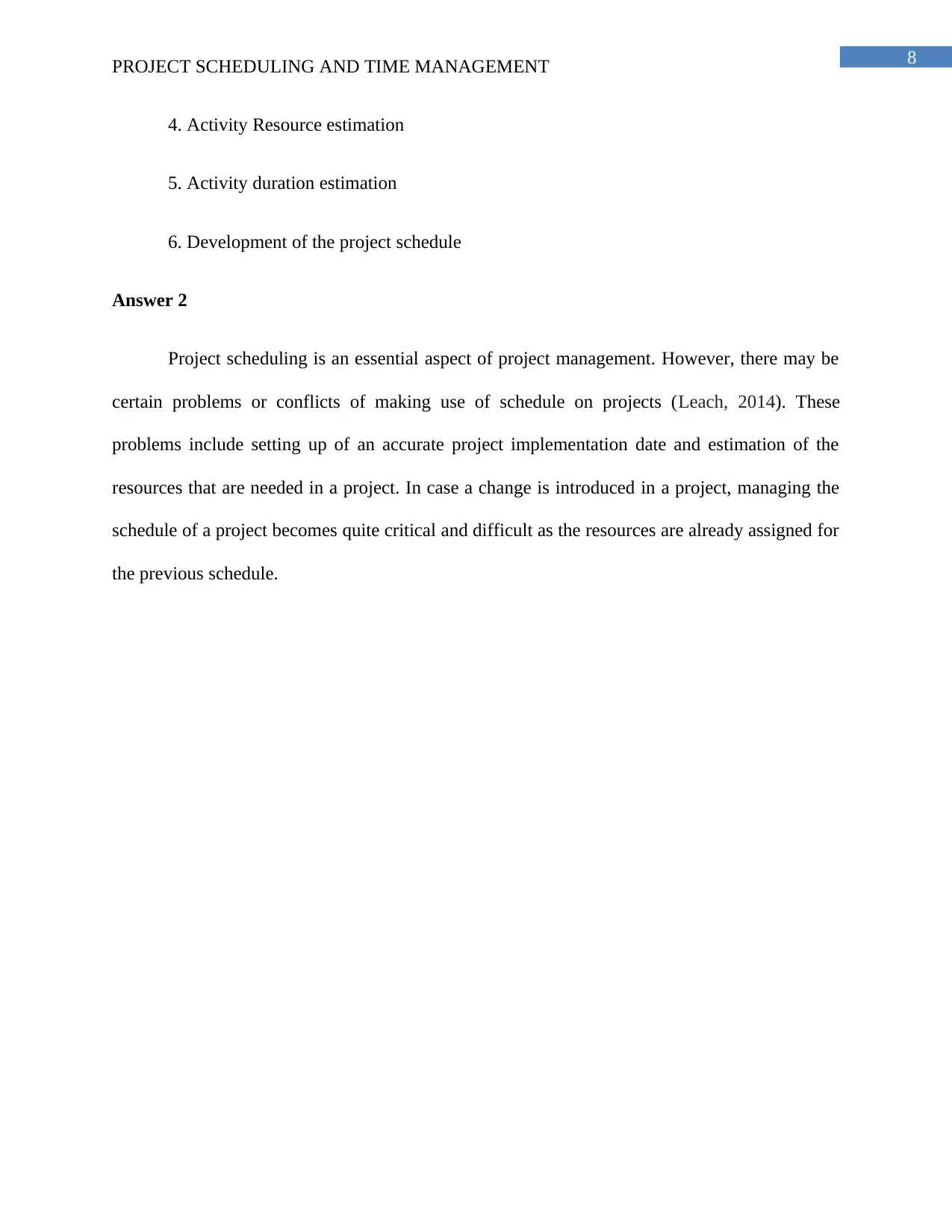
8PROJECT SCHEDULING AND TIME MANAGEMENT
4. Activity Resource estimation
5. Activity duration estimation
6. Development of the project schedule
Answer 2
Project scheduling is an essential aspect of project management. However, there may be
certain problems or conflicts of making use of schedule on projects (Leach, 2014). These
problems include setting up of an accurate project implementation date and estimation of the
resources that are needed in a project. In case a change is introduced in a project, managing the
schedule of a project becomes quite critical and difficult as the resources are already assigned for
the previous schedule.
4. Activity Resource estimation
5. Activity duration estimation
6. Development of the project schedule
Answer 2
Project scheduling is an essential aspect of project management. However, there may be
certain problems or conflicts of making use of schedule on projects (Leach, 2014). These
problems include setting up of an accurate project implementation date and estimation of the
resources that are needed in a project. In case a change is introduced in a project, managing the
schedule of a project becomes quite critical and difficult as the resources are already assigned for
the previous schedule.
⊘ This is a preview!⊘
Do you want full access?
Subscribe today to unlock all pages.

Trusted by 1+ million students worldwide
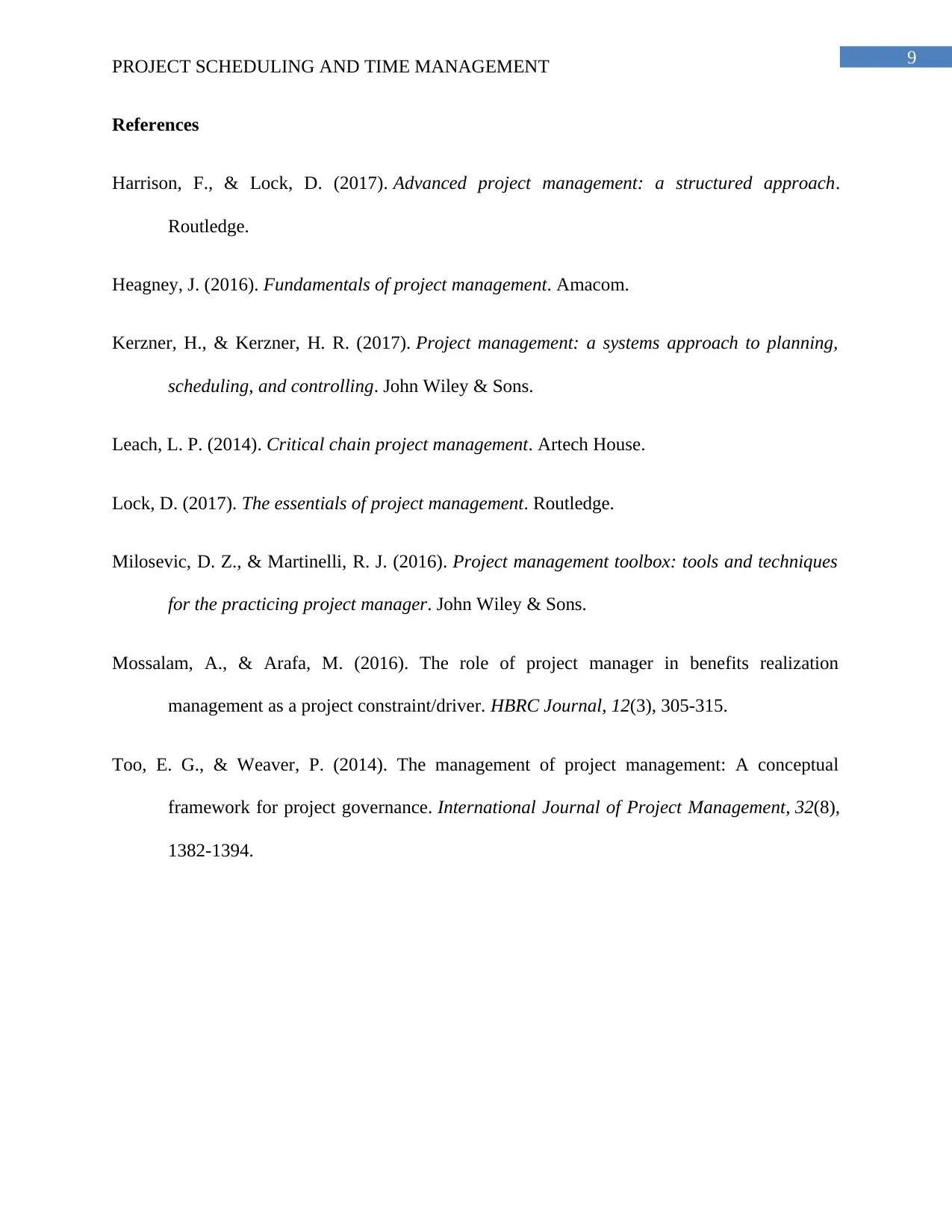
9PROJECT SCHEDULING AND TIME MANAGEMENT
References
Harrison, F., & Lock, D. (2017). Advanced project management: a structured approach.
Routledge.
Heagney, J. (2016). Fundamentals of project management. Amacom.
Kerzner, H., & Kerzner, H. R. (2017). Project management: a systems approach to planning,
scheduling, and controlling. John Wiley & Sons.
Leach, L. P. (2014). Critical chain project management. Artech House.
Lock, D. (2017). The essentials of project management. Routledge.
Milosevic, D. Z., & Martinelli, R. J. (2016). Project management toolbox: tools and techniques
for the practicing project manager. John Wiley & Sons.
Mossalam, A., & Arafa, M. (2016). The role of project manager in benefits realization
management as a project constraint/driver. HBRC Journal, 12(3), 305-315.
Too, E. G., & Weaver, P. (2014). The management of project management: A conceptual
framework for project governance. International Journal of Project Management, 32(8),
1382-1394.
References
Harrison, F., & Lock, D. (2017). Advanced project management: a structured approach.
Routledge.
Heagney, J. (2016). Fundamentals of project management. Amacom.
Kerzner, H., & Kerzner, H. R. (2017). Project management: a systems approach to planning,
scheduling, and controlling. John Wiley & Sons.
Leach, L. P. (2014). Critical chain project management. Artech House.
Lock, D. (2017). The essentials of project management. Routledge.
Milosevic, D. Z., & Martinelli, R. J. (2016). Project management toolbox: tools and techniques
for the practicing project manager. John Wiley & Sons.
Mossalam, A., & Arafa, M. (2016). The role of project manager in benefits realization
management as a project constraint/driver. HBRC Journal, 12(3), 305-315.
Too, E. G., & Weaver, P. (2014). The management of project management: A conceptual
framework for project governance. International Journal of Project Management, 32(8),
1382-1394.
1 out of 10
Related Documents
Your All-in-One AI-Powered Toolkit for Academic Success.
+13062052269
info@desklib.com
Available 24*7 on WhatsApp / Email
![[object Object]](/_next/static/media/star-bottom.7253800d.svg)
Unlock your academic potential
Copyright © 2020–2025 A2Z Services. All Rights Reserved. Developed and managed by ZUCOL.




